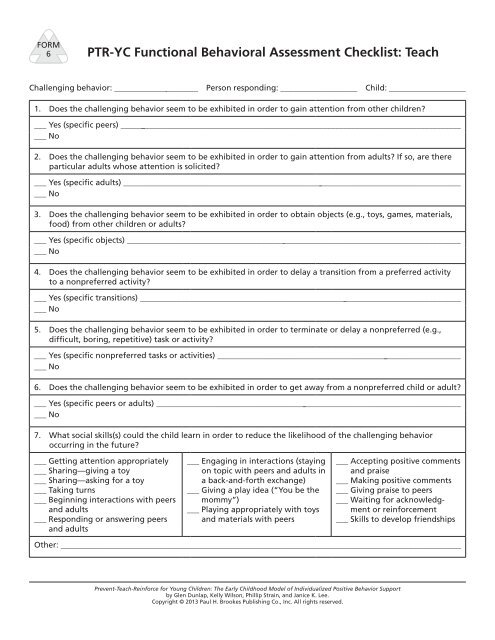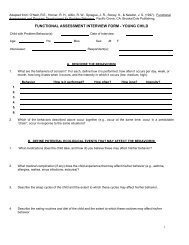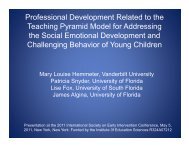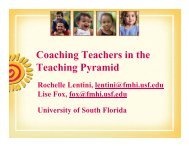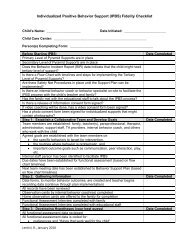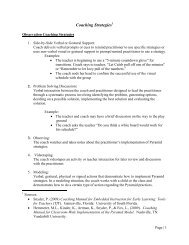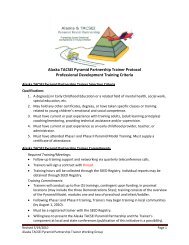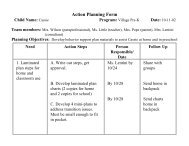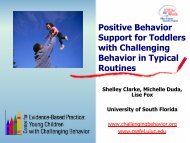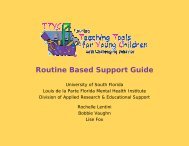PTR-YC Functional Behavioral Assessment Checklist: Teach
PTR-YC Functional Behavioral Assessment Checklist: Teach
PTR-YC Functional Behavioral Assessment Checklist: Teach
Create successful ePaper yourself
Turn your PDF publications into a flip-book with our unique Google optimized e-Paper software.
Form6<strong>PTR</strong>-<strong>YC</strong> <strong>Functional</strong> <strong>Behavioral</strong> <strong>Assessment</strong> <strong>Checklist</strong>: <strong>Teach</strong>Challenging behavior: _____________________ Person responding: ___________________ Child: ___________________1. Does the challenging behavior seem to be exhibited in order to gain attention from other children?___ Yes (specific peers) _______________________________________________________________________________________ No2. Does the challenging behavior seem to be exhibited in order to gain attention from adults? If so, are thereparticular adults whose attention is solicited?___ Yes (specific adults) _______________________________________________________________________________________ No3. Does the challenging behavior seem to be exhibited in order to obtain objects (e.g., toys, games, materials,food) from other children or adults?___ Yes (specific objects) ______________________________________________________________________________________ No4. Does the challenging behavior seem to be exhibited in order to delay a transition from a preferred activityto a nonpreferred activity?___ Yes (specific transitions) __________________________________________________ ________________________________ No5. Does the challenging behavior seem to be exhibited in order to terminate or delay a nonpreferred (e.g.,difficult, boring, repetitive) task or activity?___ Yes (specific nonpreferred tasks or activities) _______________________________________________________________ No6. Does the challenging behavior seem to be exhibited in order to get away from a nonpreferred child or adult?___ Yes (specific peers or adults) ____________________________________ __________________________________________ No7. What social skills(s) could the child learn in order to reduce the likelihood of the challenging behavioroccurring in the future?___ Getting attention appropriately___ Sharing—giving a toy___ Sharing—asking for a toy___ Taking turns___ Beginning interactions with peersand adults___ Responding or answering peersand adults___ Engaging in interactions (stayingon topic with peers and adults ina back-and-forth exchange)___ Giving a play idea (“You be themommy”)___ Playing appropriately with toysand materials with peers___ Accepting positive commentsand praise___ Making positive comments___ Giving praise to peers___ Waiting for acknowledgmentor reinforcement___ Skills to develop friendshipsOther: ___________________________________________________________________________________________________Prevent-<strong>Teach</strong>-Reinforce for Young Children: The Early Childhood Model of Individualized Positive Behavior Supportby Glen Dunlap, Kelly Wilson, Phillip Strain, and Janice K. Lee.Copyright © 2013 Paul H. Brookes Publishing Co., Inc. All rights reserved.
Form6<strong>PTR</strong>-<strong>YC</strong> <strong>Functional</strong> <strong>Behavioral</strong> <strong>Assessment</strong> <strong>Checklist</strong>: <strong>Teach</strong>(continued)8. What problem-solving skill(s) could the child learn in order to reduce the likelihood of the challengingbehavior occurring in the future?___ Controlling anger___ Controlling impulsive behavior___ Strategies for calming down___ Asking for help___ Using visuals to support independentplay___ Self-management___ Playing independently___ Playing cooperatively___ Following directions___ Following schedules androutines___ Accepting “no”___ Managing emotions___ Getting engaged in an activity___ Staying engaged in activities___ Choosing appropriate solutions___ Making choices from appropriateoptions___ Following through with choicesOther: ___________________________________________________________________________________________________9. What communication skill(s) could the child learn in order to reduce the likelihood of the challengingbehavior occurring in the future?___ Asking for a break___ Asking for help___ Responding to others___ Requesting wants and needs___ Communicating effectivelywith words___ Communicating effectivelywith pictures___ Communicating effectivelywith sign language___ Expressing emotions (e.g.,frustration, anger, hurt)appropriately___ Saying, “No” or “Stop”Other: ___________________________________________________________________________________________________Additional comments not addressed.Prevent-<strong>Teach</strong>-Reinforce for Young Children: The Early Childhood Model of Individualized Positive Behavior Supportby Glen Dunlap, Kelly Wilson, Phillip Strain, and Janice K. Lee.Copyright © 2013 Paul H. Brookes Publishing Co., Inc. All rights reserved.


